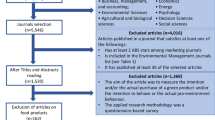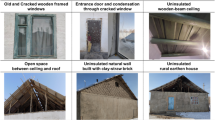Abstract
Rapid developments followed by the industrial revolution had a huge impact on the ecosystem. The concern for the ecosystem paved the way for the concept of sustainability along with its three mutually reinforcing and interdependent economic, social, and environmental dimensions. The need for sustainability is reflected in almost every field and is also seen in the construction industry in the form of green/sustainable building practices. In 2002, World Green Building Council (WGBC) was established with Green Building Councils (GBCs) representing various countries for promoting sustainable buildings. Green Building Rating Systems (GBRS) were established by GBCs to acknowledge buildings that adopt sustainable construction practices. In this context, GBRS needs much attention along with its structural framework. Many researchers have analyzed the structural framework of GBRS, and most of the studies were confined to general and category levels. Therefore, the current study attempts to investigate the weightage of sustainability dimensions through the building lifecycle by conducting a criteria-level analysis of GBRS. The weightage for three sustainability dimensions considered by GBRS was investigated through a questionnaire survey using the Budget Allocation Method (BAM). The weightage for each stage of the building lifecycle considered by GBRS was also investigated. The study also explored the relationship between sustainability dimensions and building lifecycle stages. The general framework of GBRS was analyzed, and suggestions for improving and refining GBRS were presented. Even though the study is restricted to four GBRS, the research outcome would be beneficial for developing/improving the GBRS towards accomplishing sustainability.





Similar content being viewed by others
Data availability
The datasets generated and/or analyzed during the current study are not publicly available since it is based on expert opinion, but are available from the corresponding author on reasonable request.
References
Black K (2010) Business statistics for contemporary decision making. John Wiley & Sons, Inc., USA
BRE Global Limited (2018) ‘BREEAM UK new construction 2018, technical manual, SD5078 2.0’
Castro MF, Mateus R, Bragança L (2015) A critical analysis of building sustainability assessment methods for healthcare buildings. Environ Dev Sustain 17(6):1381–1412. https://doi.org/10.1007/s10668-014-9611-0
Charoenkit S, Kumar S (2014) Environmental sustainability assessment tools for low carbon and climate resilient low income housing settlements. Renew Sust Energ Rev Elsevier 38:509–525. https://doi.org/10.1016/j.rser.2014.06.012
Doan DT et al (2017) A critical comparison of green building rating systems. Build Environ 123:243–260. https://doi.org/10.1016/j.buildenv.2017.07.007
GRIHA Council/TERI (2019) ‘GRIHA version 2019’
IGBC (2016) ‘IGBC green new buildings rating system version 3’
Illankoon IMCS, Tam VWY, Le KN (2017) Environmental, economic, and social parameters in international green building rating tools. J Prof Issues Eng Educ Pract 143(2):05016010. https://doi.org/10.1061/(ASCE)EI.1943-5541.0000313
IUCN (1980) World conservation strategy. Environmental Policy and Law 6(2):102–102. https://doi.org/10.1016/S0378-777X(80)80056-4
IUCN (1991) Caring for the earth. Gland, Switzerland Available at: http://www.iucn.org/knowledge/publications_doc/publications/
Kang HJ (2015) Development of a systematic model for an assessment tool for sustainable buildings based on a structural framework. Energy and Buildings 104:287–301. https://doi.org/10.1016/j.enbuild.2015.07.015
Kang HJ, Rhee EK (2014) A comparative analysis of performance assessment tools for establishing evaluation framework for sustainable buildings. Archit Res 16(4):131–137. https://doi.org/10.5659/AIKAR.2014.16.4.131
Komeily A, Srinivasan RS (2015) A need for balanced approach to neighborhood sustainability assessments: a critical review and analysis. Sustain Cities Soc 18:32–43. https://doi.org/10.1016/j.scs.2015.05.004
Kulkarni V, Ramachandra TV (2009) Environmental management. TERI Press
Lazar N, Chithra K (2020) A comprehensive literature review on development of building sustainability assessment systems. Journal of Building Engineering 32:101450. https://doi.org/10.1016/j.jobe.2020.101450
Lazar N, Chithra K (2021) Comprehensive bibliometric mapping of publication trends in the development of building sustainability assessment systems. Environ Dev Sustain 23(4):4899–4923. https://doi.org/10.1007/s10668-020-00796-w
Li Y et al (2017) A review of studies on green building assessment methods by comparative analysis. Energy and Buildings 146:152–159. https://doi.org/10.1016/j.enbuild.2017.04.076
Nardo M et al (2008) Handbook on constructing composite indicators: methodology and user guide. OECD. https://doi.org/10.1787/9789264043466-en
Park J, Yoon J, Kim K-H (2017) Critical review of the material criteria of building sustainability assessment tools. Sustainability 9(2):186. https://doi.org/10.3390/su9020186
Sabnis A, Pranesh MR (2017) Sustainability evaluation of buildings in pre-use phase using figure of merit as a new tool. Energy and Buildings 145:121–129. https://doi.org/10.1016/j.enbuild.2017.02.063
Siew YJRC, Balatbat AM, Carmichael GD (2013) A review of building/infrastructure sustainability reporting tools (SRTs). Smart and Sustainable Built Environment 2(2):106–139. https://doi.org/10.1108/SASBE-03-2013-0010
Tomšič M, Šijanec Zavrl M (2018) Development of a sustainability assessment method for buildings – the OPEN HOUSE case. Facilities 36(1–2):76–102. https://doi.org/10.1108/F-01-2017-0007
Triantaphyllou E (2000) Multi-criteria decision making methods: a comparative study. Springer US (Applied Optimization), Boston. https://doi.org/10.1007/978-1-4757-3157-6
UN (2005) United Nations general assembly: outcome of the 2005 world summit on social development, United Nations general assembly, September 2005. Available at: http://data.unaids.org/topics/universalaccess/worldsummitoutcome_resolution_24oct2005_en.pdf (Accessed: 28 July 2017)
USGBC (2021) ‘LEED v4.1 building design and construction’
Velasquez M, Hester PT (2013) An analysis of multi-criteria decision making methods. Int J Oper Res 10(2):56–66
WCED (1987) Report of the World Commission on environment and development: our common future. Available at: http://www.un-documents.net/our-common-future.pdf (Accessed: 28 July 2017)
WGBC (2017) Home - World Green Building Council. Available at: http://www.worldgbc.org/ (Accessed: 26 July 2017)
Worldwatch Institute (2013) Is Sustainability Still Possible? Edited by State of the World 2013. Available at: http://blogs.worldwatch.org/sustainabilitypossible/wp-content/uploads/2013/03/SOW2013-01-Engelman.pdf (Accessed: 28 July 2017)
Zardari NH et al (2015) Weighting methods and their effects on multi-criteria decision making model outcomes in water resources management. Springer International Publishing (SpringerBriefs in Water Science and Technology), Cham. https://doi.org/10.1007/978-3-319-12586-2
Acknowledgements
The authors are grateful to all the experts for participating in the survey and providing the required information for the successful completion of the study. The authors are also grateful to the editors and anonymous reviewers for their constructive and helpful suggestions, which helped to improve the quality of the paper.
Author information
Authors and Affiliations
Contributions
NL contributed towards conceptualization, methodology, data curation, formal analysis, investigation, visualization, and writing — original draft. KC contributed towards project administration, resources, supervision, validation, and writing — review and editing. All authors read and approved the final manuscript.
Corresponding author
Ethics declarations
Ethics approval and consent to participate
Not applicable.
Consent for publication
Not applicable.
Competing interests
The authors declare no competing interests.
Additional information
Responsible Editor: Philippe Garrigues
Publisher’s note
Springer Nature remains neutral with regard to jurisdictional claims in published maps and institutional affiliations.
Appendix
Appendix

Rights and permissions
About this article
Cite this article
Lazar, N., Chithra, K. Green Building Rating Systems from the prospect of sustainability dimensions through the building lifecycle. Environ Sci Pollut Res 29, 51054–51064 (2022). https://doi.org/10.1007/s11356-021-16682-5
Received:
Accepted:
Published:
Issue Date:
DOI: https://doi.org/10.1007/s11356-021-16682-5




